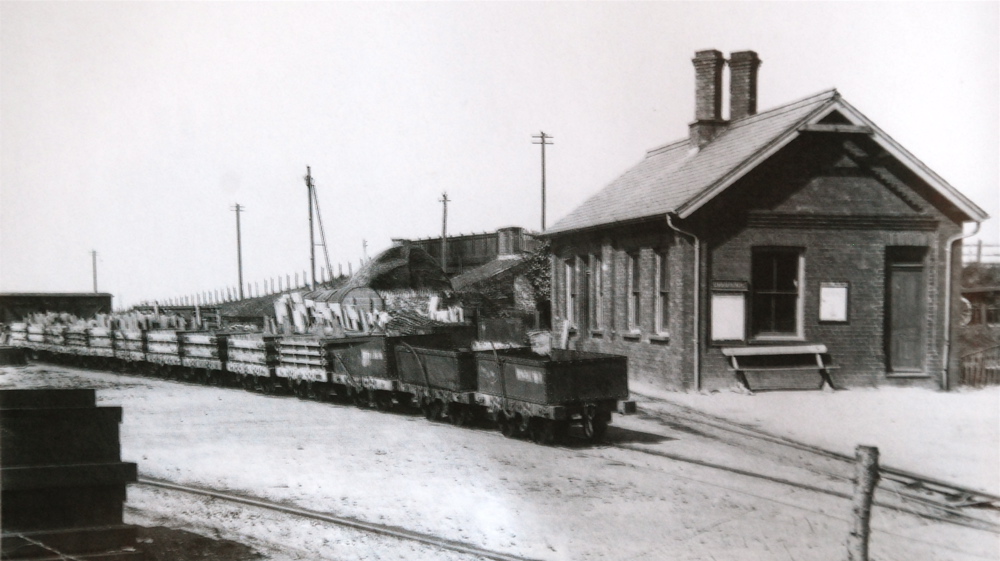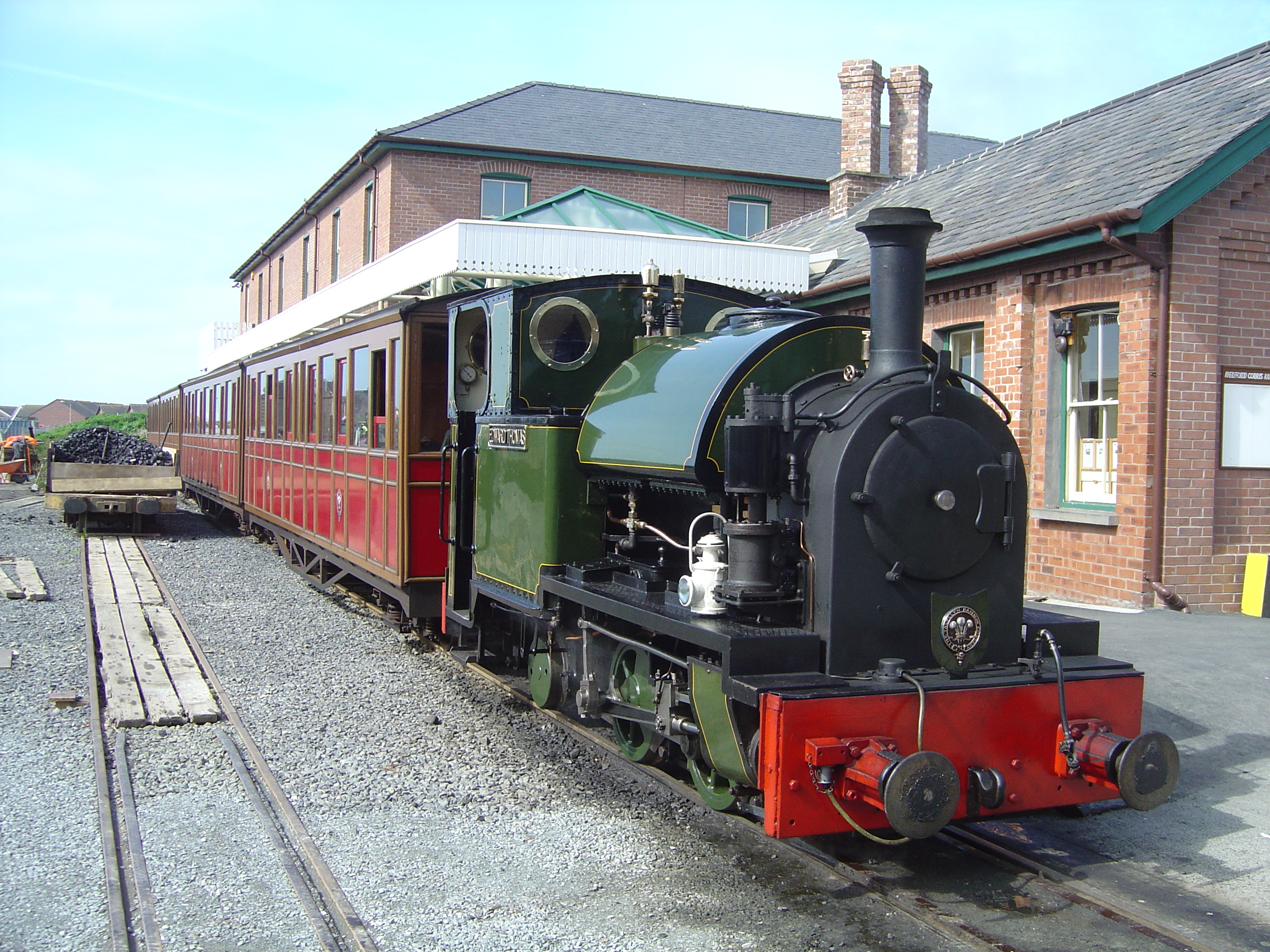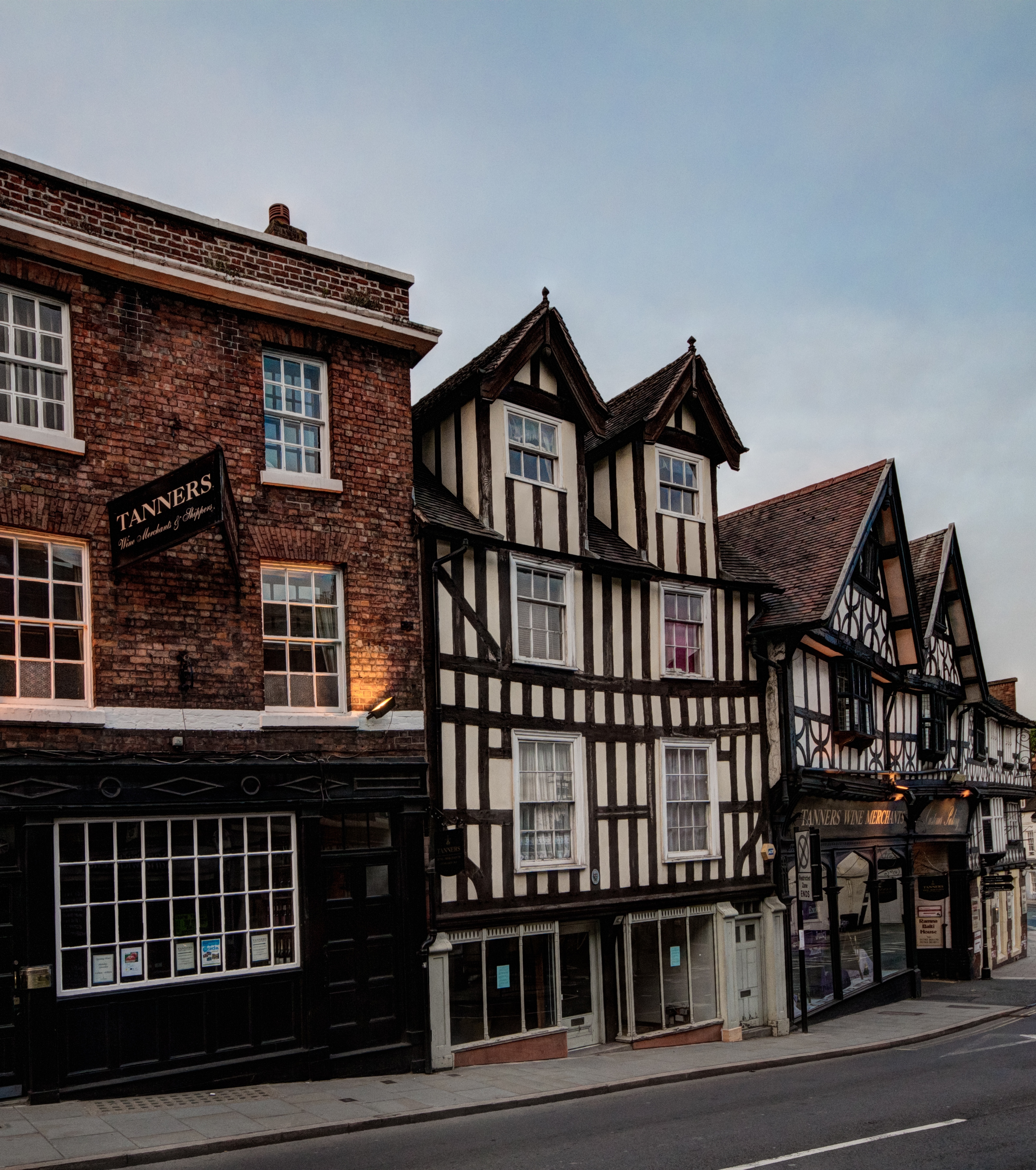|
Dolgoch (locomotive)
''Dolgoch'' is a narrow gauge 0-4-0 well tank steam locomotive. It was built by Fletcher, Jennings & Co. and is one of the oldest locomotives still in active service. It was delivered to the Talyllyn Railway in 1866Boyd 1988 and continues to run on this railway to this day. ''Dolgoch'' holds an important place in railway preservation history as it was the only serviceable locomotive on the Talyllyn Railway when it became the first preserved railway to be operated by volunteers, in 1951. ''Dolgoch'' kept the railway going during this first season. Design The design is unusual for an 0-4-0. It has a long wheelbase and the driving axle is behind the firebox in a layout similar to a Crampton locomotive. This prevents the use of a conventional valve gear layout which is driven from the rear axle. Instead, the Allan valve gear is driven from the leading coupled axle and doubled back to connect to the valve rods. ''Dolgoch'' has two water tanks - the main well tank between the f ... [...More Info...] [...Related Items...] OR: [Wikipedia] [Google] [Baidu] |
Tywyn Wharf Railway Station
Tywyn Wharf railway station is the western terminus and principal station of the Talyllyn Railway in Tywyn, Gwynedd in mid-Wales. History Originally called King's station after a local landowner, it was not a passenger station at first, but a place for transhipment of slates from the narrow gauge to the adjoining Cambrian Railway. Passenger trains started at the next station, . The original TR plans included a spur into the standard gauge station called 'Railway No 2', but in the end it wasn't necessary, traffic wasn't sufficient and the powers to build it lapsed. The earliest recorded passenger train from Wharf was in 1877, though there is circumstantial evidence of them even earlier than that. Around 1910, the station was renamed Towyn Wharf, although the name of "King's station" continued to be used for formal occasions until at least 1915. The station had no run-round loop at the time; shunting was carried out by propelling trains up the gradient out of the station and a ... [...More Info...] [...Related Items...] OR: [Wikipedia] [Google] [Baidu] |
Pretoria
Pretoria () is South Africa's administrative capital, serving as the seat of the executive branch of government, and as the host to all foreign embassies to South Africa. Pretoria straddles the Apies River and extends eastward into the foothills of the Magaliesberg mountains. It has a reputation as an academic city and center of research, being home to the Tshwane University of Technology (TUT), the University of Pretoria (UP), the University of South Africa (UNISA), the Council for Scientific and Industrial Research (CSIR), and the Human Sciences Research Council. It also hosts the National Research Foundation and the South African Bureau of Standards. Pretoria was one of the host cities of the 2010 FIFA World Cup. Pretoria is the central part of the City of Tshwane Metropolitan Municipality which was formed by the amalgamation of several former local authorities, including Bronkhorstspruit, Centurion, Cullinan, Hammanskraal and Soshanguve. Some have proposed ch ... [...More Info...] [...Related Items...] OR: [Wikipedia] [Google] [Baidu] |
Preserved Narrow Gauge Steam Locomotives Of Great Britain
Preservation may refer to: Heritage and conservation * Preservation (library and archival science), activities aimed at prolonging the life of a record while making as few changes as possible * ''Preservation'' (magazine), published by the National Trust for Historic Preservation * Historic preservation, endeavor to preserve, conserve and protect buildings, objects, landscapes or other artifacts * Conservation and restoration of cultural heritage, protection and care of tangible cultural heritage Mathematics and computer science * Type preservation, property of a type system if evaluation of expressions does not cause their type to change * Case preservation, when computer storage preserves the distinction between upper and lower case * Digital preservation, endeavor to ensure that digital information of continuing value remains accessible and usable Arts and entertainment * ''Preservation'' (2018 novel), historical fiction by Jock Serong about the wreck of the ''Sydney ... [...More Info...] [...Related Items...] OR: [Wikipedia] [Google] [Baidu] |
Individual Locomotives Of Great Britain
An individual is that which exists as a distinct entity. Individuality (or self-hood) is the state or quality of being an individual; particularly (in the case of humans) of being a person unique from other people and possessing one's own needs or goals, rights and responsibilities. The concept of an individual features in diverse fields, including biology, law, and philosophy. Etymology From the 15th century and earlier (and also today within the fields of statistics and metaphysics) ''individual'' meant " indivisible", typically describing any numerically singular thing, but sometimes meaning "a person". From the 17th century on, ''individual'' has indicated separateness, as in individualism. Law Although individuality and individualism are commonly considered to mature with age/time and experience/wealth, a sane adult human being is usually considered by the state as an "individual person" in law, even if the person denies individual culpability ("I followed instr ... [...More Info...] [...Related Items...] OR: [Wikipedia] [Google] [Baidu] |
Talyllyn Railway Locomotives
Talyllyn or Tal-y-llyn can refer to: *Tal-y-llyn, Gwynedd, the hamlet and former parish in Gwynedd in Wales **Tal-y-llyn Lake, a glacial ribbon lake east of Abergynolwyn **Talyllyn Railway The Talyllyn Railway ( cy, Rheilffordd Talyllyn) is a narrow gauge preserved railway in Wales running for from Tywyn on the Mid-Wales coast to Nant Gwernol near the village of Abergynolwyn. The line was opened in 1865Drummond 2015, page ..., a preserved narrow gauge railway running from Tywyn to Abergynolwn ** ''Talyllyn'' (locomotive), one of the original locomotives of the Talyllyn Railway *Talyllyn and Llanfihangel Talyllyn, small settlements in the Powys community of Llangors ** Talyllyn Junction, a nearby junction on the Mid Wales Railway in Powys * Tal-y-llyn, Anglesey, a former episcopal township on Anglesey ** St Mary's Church, Tal-y-llyn, the township's church {{disambig ... [...More Info...] [...Related Items...] OR: [Wikipedia] [Google] [Baidu] |
Wilbert Awdry
Wilbert Vere Awdry (15 June 1911 – 21 March 1997) was an English Anglican minister, railway enthusiast, and children's author. He was best known for creating Thomas the Tank Engine. Thomas and several other characters he created appeared in his '' Railway Series''. Life and career Wilbert Awdry was born at Ampfield vicarage near Romsey, Hampshire, on 15 June 1911. His father was Vere Awdry (1854–1928), the Anglican vicar of Ampfield (who was 56 years old at the time of his birth), and his mother was Lucy Awdry (née Bury; 1884–1965). ''Wilbert'' was derived from William and Herbert, names of his father's two brothers. His younger brother, George, was born on 10 August 1916 and died on 27 October 1994. All three of Awdry's older half-siblings from his father's first two marriages died young, the youngest being killed in World War I. At Ampfield as a toddler he saw his father construct a handmade , model railway. In 1917, the family moved to Box, in Wiltshire, moving ... [...More Info...] [...Related Items...] OR: [Wikipedia] [Google] [Baidu] |
The Railway Series
''The Railway Series'' is a series of British books about a railway known as the North Western Railway, located on the fictional Island of Sodor. There are 42 books in the series, the first published in May 1945 by the Rev. Wilbert Awdry. Twenty-five more books were written by Awdry, the final one being written in October 1972. Sixteen more were written by his son, Christopher Awdry, between September 1983 and July 2011. The series features many anthropomorphic vehicles, including Thomas the Tank Engine. Thomas became the most popular & famous character in the series and the titular character of the television series '' Thomas & Friends'' from 1984 to 2021. Many characters and stories from the books formed the basis of the children's television series. Nearly all of ''The Railway Series'' stories were based on real-life events. As a lifelong railway enthusiast, Awdry was keen that his stories should be as realistic as possible. The engine characters were mostly based upon ... [...More Info...] [...Related Items...] OR: [Wikipedia] [Google] [Baidu] |
Rheneas
This article is about the characters that have appeared in the books of ''The Railway Series'' by the Rev. Wilbert Awdry and Christopher Awdry. Unless otherwise stated on this page, the technical notes come from actual notes laid out by Wilbert Awdry when he was developing the characters and setting for his stories; these notes are cited in his publication ''The Island of Sodor: Its People, History, and Railways''. North Western Railway These are the main rolling stock of the North Western Railway (NWR), commonly referred to as the Fat Controller's railway: Steam engines The Eight Famous Engines =Thomas (Number 1)= ''Thomas'' is a blue ex-London, Brighton and South Coast Railway E2 class locomotive. =Edward (Number 2)= ''Edward'' is an old blue ex-Furness Railway K2 class locomotive. He is the first character to appear in ''The Railway Series''. =Henry (Number 3)= ''Henry'' was originally a designed by Sir Nigel Gresley. He was built circa 1919 and arrived on Sodo ... [...More Info...] [...Related Items...] OR: [Wikipedia] [Google] [Baidu] |
Edward Thomas (locomotive)
''Edward Thomas'' is a narrow gauge steam locomotive. Built by Kerr Stuart & Co. Ltd. at the California Works, Stoke-on-Trent in 1921, it was delivered new to the Corris Railway where it ran until 1948. After that railway closed, the locomotive was brought to the Talyllyn Railway in 1951, then restored, and remains in working order at the heritage railway. It has carried the operating number 4 under four successive owners. History Corris Railway The Corris Railway was a gauge tramway built in 1859, which ran from Machynlleth north to Corris and on to Aberllefenni to serve local slate quarries. The railway company owned three locomotives, built in 1878; by the end of World War I all three were in poor condition, and the railway ordered a fourth, a modified version of Kerr Stuart's "Tattoo" class, in 1921. It initially struggled with the workload on the Corris and was provided with a new boiler with a greater number of tubes in 1928. The Corris Railway was taken over by the ... [...More Info...] [...Related Items...] OR: [Wikipedia] [Google] [Baidu] |
Talyllyn (locomotive)
''Talyllyn'' is a narrow gauge steam locomotive. It was built by Fletcher, Jennings & Co. in 1864 and is one of the oldest locomotives still in active service. It was delivered to the Talyllyn Railway on 24 September 1864 and continues to run on this railway. History The Talyllyn Railway ordered two locomotives for its opening in 1865, ''Talyllyn'' and '' Dolgoch''. Both were built by Fletcher, Jennings & Co. of Whitehaven, although to two very different designs. ''Talyllyn'' was the first order the company had delivered to north Wales and the first narrow gauge locomotive they had built with plate frames. It was built to the company's ''C Class'' design, although it was the first member of its class to be built to a gauge less than . The saddle tank locomotive was originally delivered as a with an open cab. Early tests on the railway showed that this wheel arrangement led to unacceptable vertical oscillation, and in January 1867, Talyllyn was returned to its manufacturer ... [...More Info...] [...Related Items...] OR: [Wikipedia] [Google] [Baidu] |
Shrewsbury
Shrewsbury ( , also ) is a market town, civil parish, and the county town of Shropshire, England, on the River Severn, north-west of London; at the 2021 census, it had a population of 76,782. The town's name can be pronounced as either 'Shrowsbury' or 'Shroosbury', the correct pronunciation being a matter of longstanding debate. The town centre has a largely unspoilt medieval street plan and over 660 listed buildings, including several examples of timber framing from the 15th and 16th centuries. Shrewsbury Castle, a red sandstone fortification, and Shrewsbury Abbey, a former Benedictine monastery, were founded in 1074 and 1083 respectively by the Norman Earl of Shrewsbury, Roger de Montgomery. The town is the birthplace of Charles Darwin and is where he spent 27 years of his life. east of the Welsh border, Shrewsbury serves as the commercial centre for Shropshire and mid-Wales, with a retail output of over £299 million per year and light industry and distributi ... [...More Info...] [...Related Items...] OR: [Wikipedia] [Google] [Baidu] |







